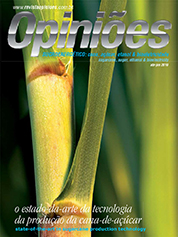José Luiz Ioriatti Demattê
Professor of the Soil and Plant Nutrition Department of Esalq-USP
Op-AA-24
Time of planting and cutting and agricultural productivity
In sugarcane farming, agricultural productivity is basically related to the effects of the climate on different types of soil, as a function of the time of planting and cutting. It is therefore necessary to adequately understand this relation to achieve the best possible results. Currently, rather using types of soil, one has resorted to information contained in Production Environments (PEs), which comprise an easier to understand agricultural planning system.
However, one must understand that PEs are not synonymous for types of soil. A shallow soil is classified as a PE, F for example, as is a sandy deep soil. On the other hand, the management of soils relates to activities to be performed as a consequence of soil charac-teristics, with the purpose of improving their quality as recipients for any given culture. PE management has to do with adapting a plant to soil characteristics and climate conditions.
Relations among time of planting, evapotranspiration (ET), PE and productivity: In the one-and-a-half-year sugarcane planting cycle, from January to April, to the extent that hydric deficit increases, productivity tends to be higher in March-April compared to January-February, a decrease less intense in more suited PEs. Planting in an area with a hydric deficit of 5 mm/day in sandy soil results in a decrease in planting productivity in January, compared to April, of up to 40% (Dematte, 2009). In short, in the one-and-a-half-year planting cycle, one should start with the most favorable PE and finish with the less favorable.
Planting in Winter: In general, when planting in Winter, from May to August, with the cutting occurring after 12 months, the decrease in productivity follows this pattern, given that it depends on the climate and is higher in less favorable PEs and lower in better PEs. In terms of management aiming at higher productivity, one should start planting in the less favorable PEs and finish in those with better fertility.
Sugarcane twelve-month cycle planting: Planting from October to November the soil must have sufficient humidity and fertilizer for good sustainable productivity, since the hydric deficit is high during the cycle. Comparatively speaking, productivity in this type of planting in favorable PEs has been 15 to 40% higher than in less favorable PEs.
Handling of ratoons in view of PEs and time of cutting: In general, most mills in the mid-South region start cutting in April and finish in mid-November.
Regardless of PEs and cutting statistics, in general the decrease in productivity occurs from April to November and may reach up to 40% in high hydric deficit regions, in a magnitude of 5mm/day (Landell and Vasconcelos, 2004). Again, such decrease is climate-dependent and is not a function of the quantity of fertilizer. Therefore, understanding the relation among PE, climate effects and time of cutting is fundamentally important to achieve the highest productivity return.
Such decrease is also related to PEs. Published results (Dematte, 2009) show that sugarcane ratoon productivity decreases in this manner in better soils, with the smallest decrease potentially reaching 8% in less fertile soils and the highest largest reaching up to 30%. The unanswered question that remains is the following: how to ease the decrease in productivity in the final cutting stage? The alternatives are as follows:
1. In a simulation conducted by Landell and Vasconcelos (2004), when they compared the end of the harvest in more fertile soil compared with less fertile soil, the increase in ratoon productivity was about 43%. Simulations were performed at the São João mill in the 2004/2005 harvest. In this case, productivity in commercial plantations from May to November in environment D was 88.5 t/ha, whereas productivity in those same areas, with planting occurring from September to November, was 76.6 t/ha.
Another simulation was made so that the entire plantation was cut from May to August. In this case, productivity increased to 95.8 t/ha, i.e., 25% more sugarcane was produced without additional spending for fertilizer and pesticides. Such results indicate that cutting should start on soils in unfavorable PEs, whereas in favorable PEs soils may be managed to allow harvesting throughout the period, but it must necessarily finish on such soils.
2. Semi-intensive ratoon irrigation: in high hydric defi-cit areas, in which ratoon irrigation is possible at the end of the harvest, applying a quantity of water sufficient to cover 40 to 45% of a PE has greatly reduced the decrease in productivity in such period. An increase in productivity, in a range of 12 to 20 t/ha, has been observed.
3. Over-mature cana: In units where there is sufficient land for areas in which the cutting occurs in mid-November and December, over-mature cana may be an adequate alternative to increase productivity.
Production environments and agricultural planning: Once it is known how PEs change with relation to hydric deficits in different regions of the mid-South, it becomes necessary to adequately plan areas, taking such factors into consideration when managing ratoons. Unfavorable environment areas should be restricted to the compartment with the precocious and medium precocious varieties and to few areas in the late compartment.
The opposite should occur in less favorable environments, in which ratoons may be cut throughout the harvest period, however it must necessarily finish on good quality soil. Throughout the planting and with all ratoons one observes the influence of the climate on the variation in productivity and therefore, fertilizer quantity should also follow such trend.




